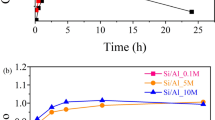Abstract
Sol–gel vitrification can be used to rapidly produce solid, vitreous materials to support nuclear forensics research. This work investigates three sol–gel synthetic approaches’ ability to retain fission products within the glass as a function of drying temperature. Eight of the ten fission products studied were quantitatively retained (less than 5% losses) at temperatures up to 600 °C for glasses prepared using an acidic catalyst and at temperatures up to 300 °C for glasses prepared using a basic catalyst. Both systems show partial loss of ruthenium and complete loss of iodine at temperatures above 300 and 100 °C, respectively.



Similar content being viewed by others
References
Straub MD, Arnold J, Fessenden J, Kiplinger JL (2021) Recent advances in nuclear forensic chemistry. Anal Chem 93:3–22
Carney KP, Finck MR, Mcgrath CA, Martin LR, Lewis RR (2014) The development of radioactive glass surrogates for fallout debris. J Radioanal Nucl Chem 299:363–372
Molgaard JJ, Auxier JD, Giminaro AV, Oldham CJ, Cook MT, Young SA, Hall HLJ (2015) Development of synthetic nuclear melt glass for forensic analysis. Radioanal Nucl Chem 304(3):1293–1301
Molgaard JJ, Auxier JD, Giminaro AV, Oldham CJ, Gill J, Hall HL (2016) Production of synthetic nuclear melt glass. J Vis Exp 107:e53473
Giminaro AV, Stratz SA, Gill JA, Auxier JP, Oldham CJ, Cook MT, Auxier JD, Molgaard JJ, Hall HL (2015) Compositional planning for development of synthetic urban nuclear melt glass. J Radioanal Nucl Chem 306(1):175–181
Liezers M, Fahey AJ, Carman AJ, Eiden GC (2015) The formation of trinitite-like surrogate nuclear explosion debris (SNED) and extreme thermal fractionation of SRM-612 glass induced by high power CW CO2 laser irradiation. J Radioanal Nucl Chem 304(2):705–715
Liezers M, Carman AJ, Eiden GC (2016) The preparation of nonradioactive glassy surrogate nuclear explosion debris (SNED) loaded with isotopically altered Xe. J Radioanal Nucl Chem 307:1811–1817
Liezers M, Endres MC, Carman AJ, Eiden GC (2018) Generating aerodynamic surrogate nuclear explosion debris (SNED). J Radioanal Nucl Chem 318(1):71–77
Brinker CJ, Scherer GW (2013) Sol-gel science: the physics and chemistry of sol-gel processing. Academic Press
Brinker CJ, Scherer GW (1985) Sol → Gel → Glass: I. Gelation and gel structure. J Non Cryst Solids 70(3):301–322
Pope EJA, Mackenzie JD (1986) Sol-gel processing of silica: II. The role of the catalyst. J Non Cryst Solids 87(1–2):185–198
Brinker CJ, Scherer GW, Roth EP (1985) Sol → Gel → Glass: II. Physical and structural evolution during constant heating rate experiments. J Non Cryst Solids 72(2–3):345–368
Buckley AM, Greenblatt M (1994) The sol-gel preparation of silica gels. J Chem Educ 71(7):599
Winter R, Chan JB, Frattini R, Jonas J (1988) The effect of fluoride on the sol-gel process. J Non Cryst Solids 105(3):214–222
Snow MS, Ward J, Bucher B, Cooper JT, Kinlaw M, Cárdenas E, Horkley J, Town H, Finck M, Carney K (2021) Rapid separation of photofissioned uranium products via a single-pass multiplexed chromatographic fission product separation system. Anal Chem 93(8):3770–3777
Acknowledgements
The authors would like to thank Dr. Edna Cardenas for assistance with arranging logistics for the irradiation experiment, Dr. Justin Cooper for guidance and advice with sol-gel chemistry preparation, and for the Idaho Accelerator Center staff, Kevin Folkman, Chad O’Neil, Brian Berls, and John Longley for their assistance in performing the irradiations. This material is based upon work supported by the National Nuclear Security Administration, Office of Defense Nuclear Nonproliferation. Neither the U.S. Government nor any agency thereof, nor any of their employees, makes any warranty, express or implied, or assumes any legal liability or responsibility for the accuracy, completeness, or usefulness of any information, apparatus, product, or process disclosed, or represents that its use would not infringe on privately owned rights. References herein to any specific commercial product, process, or service by trade name, trademark, manufacturer, or otherwise, do not necessarily constitute or imply its endorsement, recommendation, or favoring by the U.S. Government or any agency thereof. Views and opinions of the authors expressed herein do not necessarily reflect those of the U.S. Government or any agency thereof.
Author information
Authors and Affiliations
Corresponding author
Ethics declarations
Conflict of interest
The authors have no competing interests to declare that are relevant to the content of this article.
Additional information
Publisher's Note
Springer Nature remains neutral with regard to jurisdictional claims in published maps and institutional affiliations.
Supplementary Information
Below is the link to the electronic supplementary material.
Rights and permissions
About this article
Cite this article
Lusk, R., Meiers, J., Bucher, B. et al. Retention of radionuclides in sol–gel surrogate nuclear explosive debris. J Radioanal Nucl Chem 332, 683–689 (2023). https://doi.org/10.1007/s10967-022-08716-0
Received:
Accepted:
Published:
Issue Date:
DOI: https://doi.org/10.1007/s10967-022-08716-0




